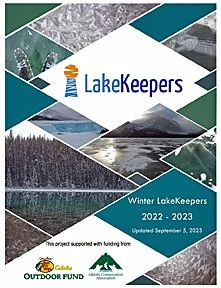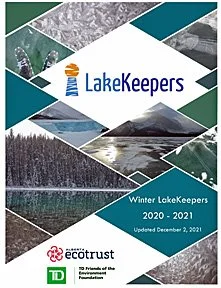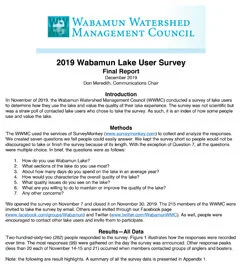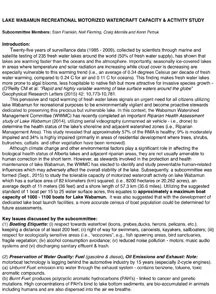Studies & Reports
The following are copies of reports about studies that have been done on Wabamun Lake over the years (1983 to present). These were done by governments, committees, consultants, the WWMC and individuals. The reports are in reverse-chronological order to the extent we could determine dates of publication.
Each winter the WWMC works with the Alberta Lake Management Society to do water quality monitoring of Wabamun Lake throughout the winter. The linked ALMS report summarizes the data collected from variety of lakes from across the province, including Wabamun.
Each winter the WWMC works with the Alberta Lake Management Society to do water quality monitoring of Wabamun Lake throughout the winter. The following ALMS report summarizes the data collected from variety of lakes from across the province, including Wabamun.
LakeWatch reports are designed to summarize basic lake data in understandable terms for the widest audience, and are not meant to be a complete synopsis of information about specific lakes. Additional information is available for many lakes that have been included in LakeWatch, and readers requiring more information are encouraged to seek those sources.
Each winter the WWMC works with the Alberta Lake Management Society to do water quality monitoring of Wabamun Lake throughout the winter. The following ALMS report summarizes the data collected from variety of lakes from across the province, including Wabamun.
Riparian assessments are tools that estimate how healthy a riparian area is and how that might correspond to ecological function within a watershed. The results can be used to support decisions about where conservation or restoration is needed to help improve the natural functions of riparian areas.
LakeWatch reports are designed to summarize basic lake data in understandable terms for the widest audience, and are not meant to be a complete synopsis of information about specific lakes. Additional information is available for many lakes that have been included in LakeWatch, and readers requiring more information are encouraged to seek those sources.
Michael Short of Let’s Go Outdoors has produced two short videos that are good overviews of what the Watershed Management Plan is all about.
Each winter the WWMC works with the Alberta Lake Management Society to do water quality monitoring of Wabamun Lake throughout the winter. The following ALMS report summarizes the data collected from variety of lakes from across the province, including Wabamun.
LakeWatch has several important objectives, one of which is to collect and interpret water quality data from Alberta’s Lakes. Equally important is educating lake users about aquatic environments, encouraging public involvement in lake management, and facilitating cooperation and partnerships between government, industry, the scientific community and lake users.
The intent of this plan is to ensure that the things we value about the lake (e.g., good water quality for swimming, adequate lake level for boating, good fishing, etc.) are maintained.
2-page summary
The intent of this plan is to ensure that the things we value about the lake (e.g., good water quality for swimming, adequate lake level for boating, good fishing, etc.) are maintained.
Full Report
Following the successful pilot of Winter LakeKeepers in February – March 2019, the Alberta Lake Management Society (ALMS) delivered a subsequent Winter LakeKeepers season from December 2019 – March 2020.
LakeWatch has several important objectives, one of which is to collect and interpret water quality data from Alberta’s Lakes. Equally important is educating lake users about aquatic environments, encouraging public involvement in lake management, and facilitating cooperation and partnerships between government, industry, the scientific community and lake users. LakeWatch reports are designed to summarize basic lake data in understandable terms for the widest audience, and are not meant to be a complete synopsis of information about specific lakes.
In November of 2019, the Wabamun Watershed Management Council (WWMC) conducted a survey of lake users to determine how they use the lake and value the quality of their lake experience. The survey was not scientific but was a straw poll of contacted lake users who chose to take the survey. As such, it is an index of how some people use and value the lake. This report summarizes the results. The Final Report includes this summary plus more detailed summaries of the data in the appendices.
In November of 2019, the Wabamun Watershed Management Council (WWMC) conducted a survey of lake users to determine how they use the lake and value the quality of their lake experience. The survey was not scientific but was a straw poll of contacted lake users who chose to take the survey. As such, it is an index of how some people use and value the lake.
On January 2, 2018, the ice on Wabamun Lake expanded laterally, buckling and heaving the shoreline, and damaging property. Along the north shore, from Seba Beach to just west of the Village of Wabamun, there was damage to some buildings and structures.
This pervasive and rapid warming of fresh water lakes signals an urgent need for all citizens utilizing lake Wabamun for recreational purposes to be environmentally vigilant and become proactive stewards dedicated to preserving this precious but vulnerable lake.
BATHTUB is an empirical eutrophication model developed by the United States Army Corps of Engineers for use on reservoirs and lakes (Walker 2006). The model was designed to calculate water and nutrient mass balances that replicate lake processes over a broad time scale. Besides simulating current conditions, BATHTUB can be used as a planning and educational tool for evaluating future watershed development/restoration scenarios.
The North Saskatchewan Watershed Alliance (NSWA) was approached by the Wabamun Watershed Management Council in 2014 to assess the health of the Riparian Management Area of Wabamun Lake.
Wabamun Lake is a popular summer destination for boaters in the Capital region. An increase in demand by boaters for improved boat launch facilities has warranted an examination of current and future boat launch facilities on the lake.
The purpose of the Wabamun Lake State of the Watershed Report is to summarize the existing current and historical knowledge of the watershed. This report outlines how natural features, natural processes, land use and water use influences the watershed.
Alberta Environment and Water (AEW) monitors the surface water quality of provincial lakes to evaluate short- and long-term environmental conditions, and to inform lake management and policy.
Retaining walls and non-vegetated shorelines are a very common sight on shore-line properties in Alberta. These urbanized shorelines have a huge impact on the lake and shoreline from impacting aquatic vegetation and fish populations to reducing the stability and diversity of lake shores.
Retaining walls and non-vegetated shorelines are a very common sight on shore-line properties in Alberta. These urbanized shorelines have a huge impact on the lake and shoreline from impacting aquatic vegetation and fish populations to reducing the stability and diversity of lake shores.
On August 29, 2009, the Alberta Conservation Team (ACT) in association with the Wabamun Watershed Management Council (WWMC) had a unique opportunity to facilitate a Shoreline Naturalization Info Session at Lake Wabamun.
Over-enrichment of nutrients and resulting excessive growth of algae (eutrophication) is a pressing issue in many Alberta lakes and is often a driving factor behind the work of local watershed stewardship groups (e.g. Wabamun Watershed Management Council).
Each of us has our own ideas of what is “good” or “poor” water quality. It depends on what we want to use the water for. For example, if our primary use of the lake is for swimming, we probably think clear water is the top priority.
The Lake Wabamun Eutrophication Study was initiated to address public concerns that water quality in this important recreational lake was dete- riorating
A plan that was developed in the 1980s but was never implemented. Nevertheless, many of the recommendations have resonance for conditions today.

































